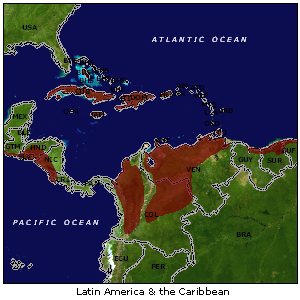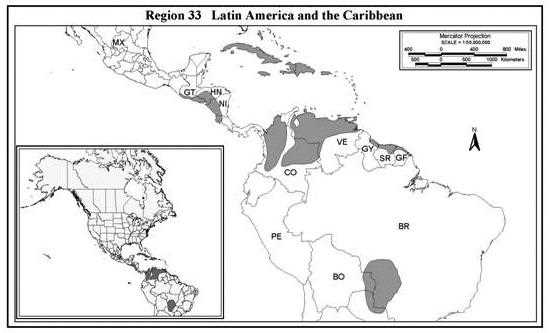Level IV Ducks Unlimited conservation priority area, major wintering area for 16 North American waterfowl species

At least 16 waterfowl species that breed in North America, including blue-winged teal, pintail and lesser scaup, spend the winter in Latin America and the Caribbean. Unfortunately, little is known about their numbers, their main staging and wintering areas, their natural history, or their basic ecological requirements. In the interest of North America's waterfowl, DU is working to learn more about this area and its wintering waterfowl, before it's too late. Since 2000, DU has worked with 11 countries in the Caribbean, Central America and South America to develop programs for monitoring the regions' waterfowl. As a result of this work, a number of important wetlands have been identified, but more information is needed.


The Latin America and Caribbean region is more than 9,654 km long and comprises seven countries in Central America, 13 in South America and 13 in the Caribbean. Also in this region, particularly in the Caribbean, a number of dependent territories still exist belonging to the United States, France, the Netherlands and the United Kingdom.
There is a great diversity in the flora and fauna throughout the many ecosystems found in the Latin America/Caribbean region due to the great variation in climate (from antarctic cold to tropical) and in elevation (from sea level to 7,000 m peaks). Although some areas as well as certain groups of plants and animals have been studied thoroughly, the wetlands and the waterfowl found in Latin America and the Caribbean remain rather poorly known to science. Wetland ecosystem richness is varied, both in terms of species diversity and their abundance. The size of wetlands varies tremendously, from wetlands only a few hundred hectares on the Andes of Colombia to millions of hectares of the Llanos in Venezuela and many more millions of acres of the Pantanal (the largest freshwater marsh in the world).
Of the 47 species of waterfowl found in Latin America and the Caribbean, 14 are shared with North America. At least 4 species are known to be threatened, but it is very possible that several more also are under immediate threat. None of the 47 species have been studied in detail, not even any of the 14 North American migrants in relation to their Latin American and Caribbean habitats, but habitat deterioration continues at a high rate further impacting the security of waterfowl species.
The narrow strip of land that connects North and South America constitutes Central America. Less than 1,609 km long and 483 km wide, this region has very diverse wetlands, but they all share similar problems. Wars occurring during the past few decades, wide-scale deforestation and erosion in the surrounding watersheds, unwise agricultural practices, wide use of agrochemicals, and reclamation of wetlands for banana, rice, and sugar cane plantations are just a few of the many threats to which these wetlands are exposed.
South American wetlands share many problems with those in Central America and the Caribbean. This is a thinly populated continent where most of the human population is concentrated in a few very large cities. However, these countries have enormous foreign debts and the governments are trying to attract large financial investments and develop liberal economic policies, which often cause serious conflict between development and conservation. For example, the Hidrovia proposal, similar to the dredging and channelization of the Mississippi River, if carried out, would involve a major modification of the Paraguay River that would alter seriously the Pantanal; or the Panamerican Highway which, if constructed, would destroy the wetlands of the Darien bottleneck between Panama and Colombia.
Caribbean wetlands probably are some of the least known, least protected, and most threatened. Threats to the integrity of these fragile, wetland ecosystems include the use of mangrove trees for charcoal and tanning; dumping of waste; land reclamation and conversion to mariculture; over-fishing; and uncontrolled and inappropriate tourism activities. The results are erosion, sedimentation, pollution and human disturbance, which negatively affect the waterfowl populations using these wetlands. In spite of the many functions performed by coastal wetlands, such as storm and flood mitigation, retention of nutrients, shoreline stabilization and tourism, and the many products generated, few wetlands in the Caribbean have received any sort of protection, let alone management plans, especially within the context of watersheds.
The Directory of Neotropical Wetlands, partially funded by DU and completed in the early 1980s, is still the only information available on wetlands across the region. One of the results of the Directory was the great interest it generated within the Latin American and Caribbean countries and the amount of information it provided for both decision-making managers and politicians, as well as for potential funding agencies. During the following two decades with support of several international organizations and funding agencies, countries started to consider wetlands among their priorities. Money and efforts were concentrated in developing policies of biodiversity, strategies, work plans, and management plans, both from international agencies as well as from national governmental institutions and NGOs. Budget cuts at all levels implied less and less research, so decision-making has been based not in what there is on the wetlands now, but on what there was two or more decades ago. Even worse, decision-making in many instances has been done by officials who have not had adequate training or the field experience necessary to implement the very strategies that they developed.
Fortunately, training has been one of the major priorities for several international agencies, such as the USFWS, the USDA USFS, The Nature Conservancy, and DU who have done much to build the institutional capacity of both NGOs and governmental agencies in Latin America and the Caribbean. Still, research and monitoring are far from being addressed properly and although these activities are considered of great importance by conservationists in the Latin American and Caribbean countries, very few international organizations are willing to support them. Enhancement and restoration are two actions which slowly are becoming of concern and interest to local governments and NGOs, but these usually are perceived as expensive and not as urgent as securing protection for areas which still appear to be in good condition. Unfortunately some of the wetlands that once were of great importance for waterfowl have disappeared or are almost gone.
Up to now, most international organizations involved in conservation in Latin America and the Caribbean have only included wetlands where and when they are of great importance to biodiversity in general, considering waterfowl just as one more taxonomic group within that biodiversity.
Clearly, there is great room for DU to deliver expertise on research and monitoring of waterfowl populations and management, as well as the enhancement and restoration of wetland habitats in Latin America and the Caribbean. Through the building of partnerships with both national and international institutions and a sound and well-focused strategy, DU would make significant contributions to wetland and waterfowl conservation in this region.
At least 14 species of the 44 North American breeding waterfowl winter south of Mexico. However, very little if anything is known about their numbers, their main staging and wintering areas, their natural history, and their basic ecological requirements. No regular surveys have been carried out over any wetland, and existing data are occasional and have been collected from small areas. Large extensions of wetlands have not been surveyed and potential threats to waterfowl populations on their wintering grounds remain unknown.
Conservation efforts at the breeding grounds must be accompanied by conservation efforts in staging and wintering grounds to ensure that the annual life cycle needs of migratory species are met. Scattered data indicate that Central America, the Caribbean, and at least the northern portion of South America are of great importance to migratory waterfowl from North America. For example, in the 1970s in Palo Verde, a 1,500 ha wetland in Costa Rica, observations were made of 60,000 blue-winged teal and several hundreds each of northern shoveler, American wigeon, ring-necked duck and lesser scaup. DU's 1994 Continental Conservation Plan indicates that most blue-winged teal winter in northern South America. In Suriname an aerial survey in the late 1970s of a portion of the coastal wetlands indicated at least 20,000 blue-winged teal, and several Cuban authors indicate that both white-fronted goose and snow goose were common winter visitors, while blue-winged teal, pintail, American wigeon, northern shoveler, wood duck, ring-necked duck, and lesser scaup are still common.
DU has been involved in a small number of projects in Latin America and the Caribbean. Money has been provided for waterfowl surveys in South America, for coastal restoration in the Bahamas, for waterfowl monitoring, and the development of a GIS and management plan for the Llanos of Venezuela.
There is tremendous potential for DU to achieve further conservation success of North American waterfowl and wetlands by developing projects in Latin America and the Caribbean. There are great opportunities to get involved in a direct and active way in projects, from the development of proposals and the search for additional funding, to the implementation of projects on the ground, whether it is using GIS technology or carrying out engineering and biological work.
Ducks Unlimited uses cookies to enhance your browsing experience, optimize site functionality, analyze traffic, and deliver personalized advertising through third parties. By continuing to use this site, you agree to our use of cookies. View Privacy Policy